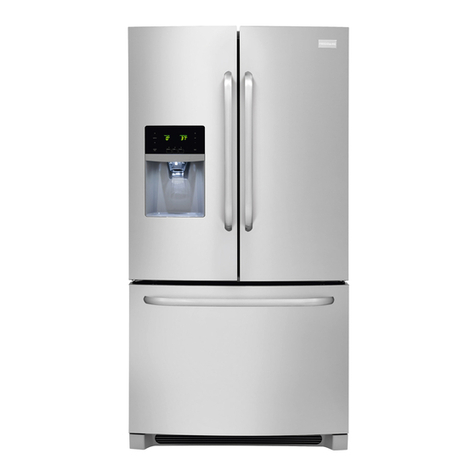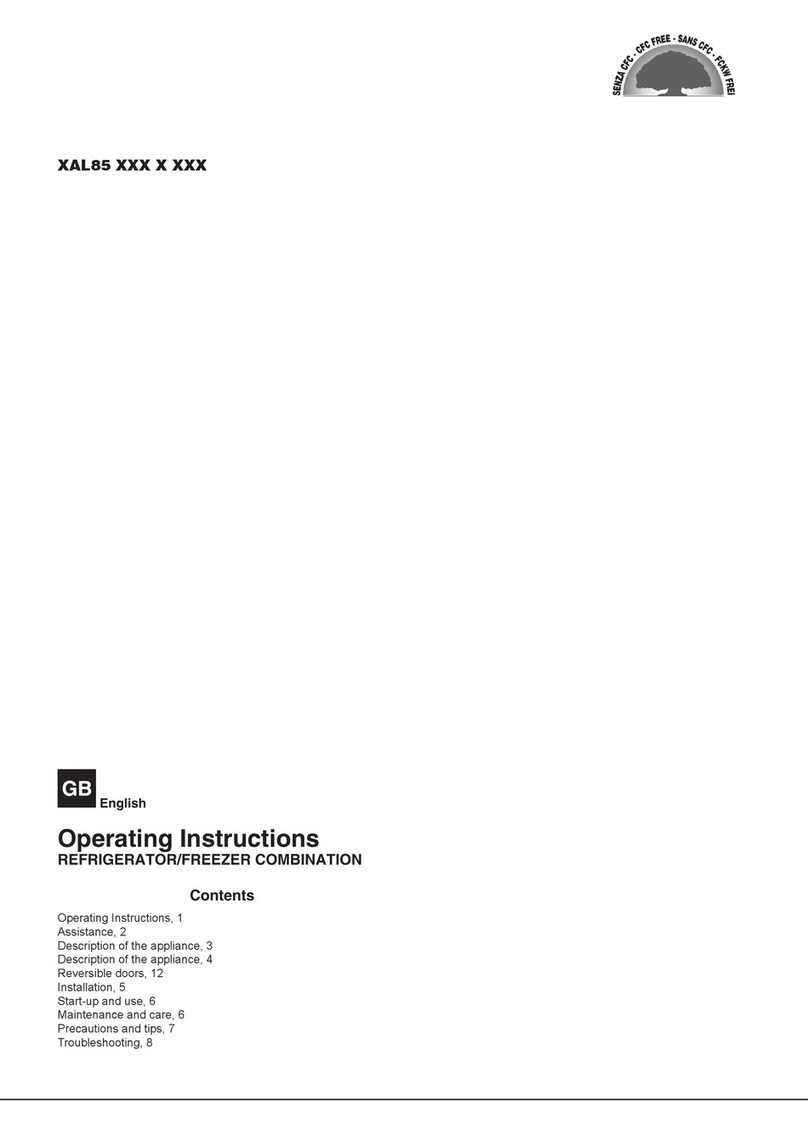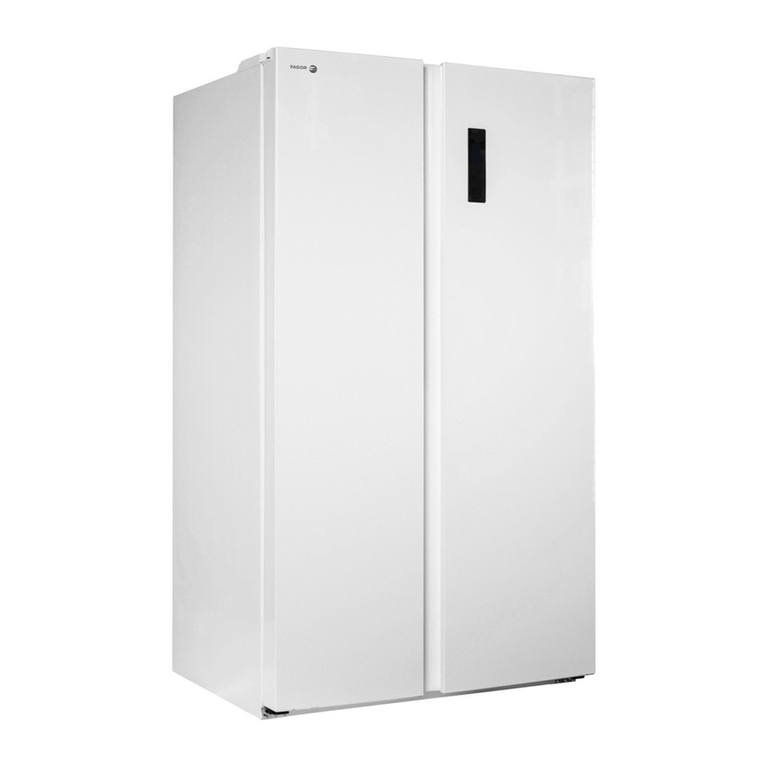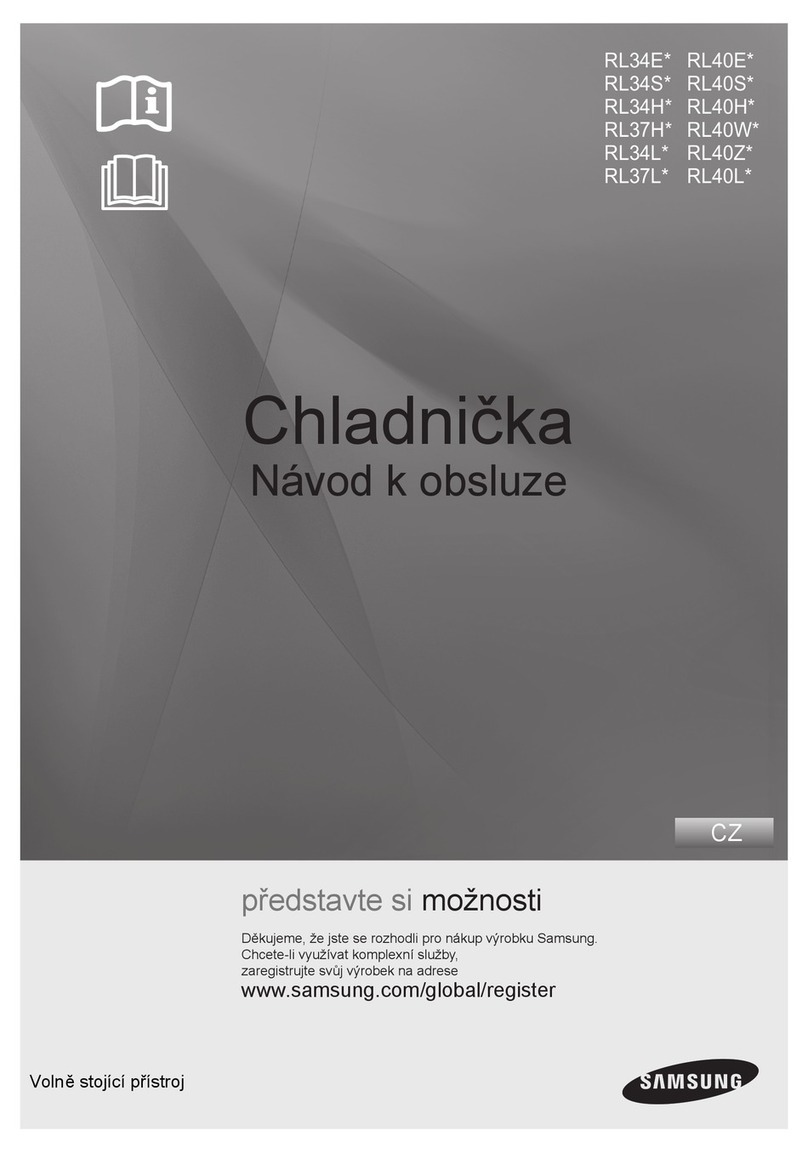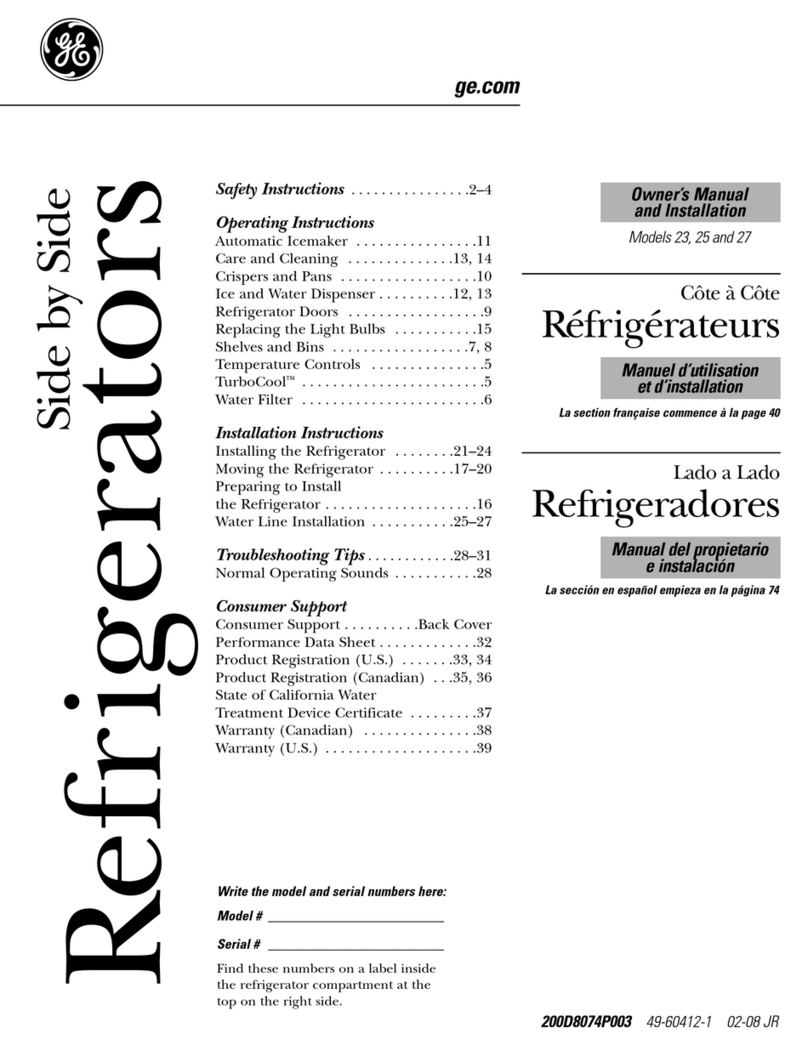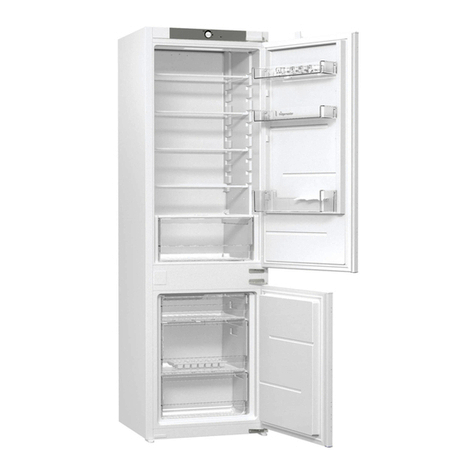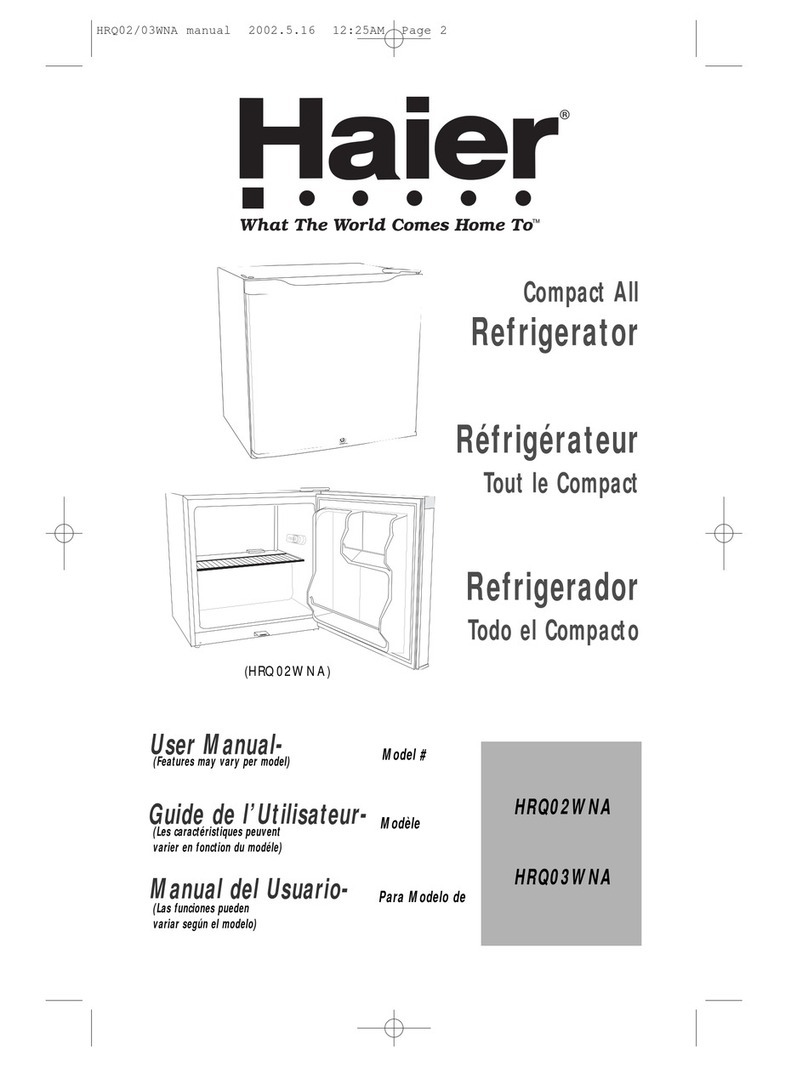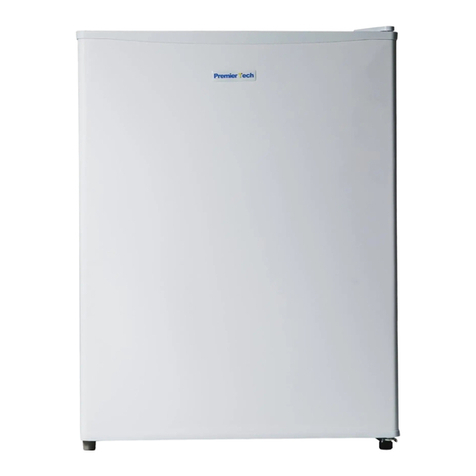ROMMER FV-290 A+ User manual

FV-290 A+
FV-291 A+
DOUBLE DOOR REFRIGERATOR
FREEZER - FRIDGE
Instruction booklet
Guide d’utilisation
FRIGORIFICO DE DOS PUERTAS
Manual de instrucciones
RÉFRIGÉRATEUR DEUX PORTES
Congélateur - Réfrigérateur

EN - 1 -
Index
BEFORE USING THE APPLIANCE ........................................................ 2
General warnings ........................................................................................... 2
Old and out-of-order fridges or freezers ........................................................... 4
Safety warnings ............................................................................................. 4
Installing and operating your fridge freezer ...................................................... 5
Before Using your fridge freezer...................................................................... 6
THE VARIOUS FUNCTION AND POSSIBILITIES..................................6
Thermostat setting ......................................................................................... 6
Warnings about temperature adjustments ...................................................... 7
Accessories .................................................................................................. 7
Ice tray ........................................................................................................................... 7
Plastic scraper ............................................................................................................. 7
ARRANGING FOOD IN THE APPLIANCE ..............................................8
Fridge compartment ....................................................................................... 8
Freezer compartment ..................................................................................... 8
CLEANING AND MAINTENANCE ........................................................... 9
Defrosting .....................................................................................................10
Replacing the light bulb ................................................................................. 11
TRANSPORTATION AND CHANGING OF INSTALLATION POSITION
11
Transportation and changing of Installation position ....................................... 11
Repositioning the door .................................................................................. 11
BEFORE CALLING YOUR AFTER SALES SERVICE .......................... 12
Tips for saving energy ...................................................................................13
THE PARTS OF THE APPLIANCE AND THE COMPARTMENTS .......14

EN - 2 -
PART - 1. BEFORE USING THE APPLIANCE
General warnings
WARNING: Keep ventilation openings, in the appliance enclosure
or in the built-in structure, clear of obstruction.
WARNING: Do not use mechanical devices or other means to
accelerate the defrosting process, other than those recommended
by the manufacturer.
WARNING: Do not use electrical appliances inside the food storage
compartments of the appliance, unless they are of the type
recommended by the manufacturer.
WARNING: Do not damage the refrigerant circuit.
WARNING: To avoid a hazard due to the instability of the appliance,
it must be fixed in accordance with the instructions.
• If your appliance uses R600a as a refrigerant (this information
will be provided on the label of the cooler) you should take
care during transportation and installation to prevent the cooler
elements from being damaged. R600a is an environmentally
friendly and natural gas, but it is explosive. In the event of a
leak due to damage of the cooler elements, move your fridge
away from open flames or heat sources and ventilate the room
where the appliance is located for a few minutes.
• While carrying and positioning the fridge, do not damage the
cooler gas circuit.
• Do not store explosive substances such as aerosol cans with a
flammable propellant in this appliance.
• This appliance is intended to be used in household and
domestic applications such as:
- staff kitchen areas in shops, offices and other working
environments.
- farm houses and by clients in hotels, motels and other

EN - 3 -
residential type environments.
- bed and breakfast type environments;
- catering and similar non-retail applications.
• If the socket does not match the refrigerator plug, it must be
replaced by the manufacturer, a service agent or similarly
qualified persons in order to avoid a hazard.
• A specially grounded plug has been connected to the power
cable of your refrigerator. This plug should be used with a
specially grounded socket of 16 amperes. If there is no such
socket in your house, please have one installed by an
authorised electrician.
• This appliance can be used by children aged from 8 years
and above and persons with reduced physical, sensory or
mental capabilities or lack of experience and knowledge if they
have been given supervision or instruction concerning use of
the appliance in a safe way and understand the hazards
involved. Children shall not play with the appliance. Cleaning
and user maintenance shall not be made by children without
supervision.
• If the supply cord is damaged, it must be replaced by the
manufacturer, an authorised service agent or similar qualified
persons, in order to avoid a hazard.
• This appliance is not intended for use at altitudes exceeding
2000 m.

EN - 4 -
Old and out-of-order fridges or freezers
• If your old fridge has a lock, break or remove the lock before discarding
it, because children may get trapped inside it and may cause an
accident.
• Old fridges and freezers may contain isolation material and refrigerant
with CFC or HFC. Therefore, take care not to harm environment when
you are discarding your old fridges.
Please ask your municipal authority about the disposal of the WEEE reuse,
recycle and recovery purposes.
Notes:
•Please read the instruction manual carefully before installing and using your
appliance. We are not responsible for the damage occurred due to misuse.
•Follow all instructions on your appliance and instruction manual, and keep this
manual in a safe place to resolve the problems that may occur in the future.
•This appliance is produced to be used in homes and it can only be used in
domestic environments and for the specified purposes. It is not suitable for
commercial or common use. Such use will cause the guarantee of the appliance
to be cancelled and our company will not be responsible for losses incurred.
•This appliance is produced to be used in houses and it is only suitable for cooling /
storing food. It is not suitable for commercial or common use and/or for storing
substances except for food. Our company is not responsible for losses to be
incurred in the contrary case.
Safety warnings
• Do not connect your Fridge Freezer to the mains
electricity supply using an extension lead.
• Do not plug in damaged, torn or old plugs.
• Do not pull, bend or damage the cord.
• This appliance is designed for use by adults, do not allow
children to play with the appliance or let them hang off the door.
• Never touch the power cord/plug with wet hands as this could
cause a short circuit or electric shock.
• Do not use any metal or sharp objects to accelerate the defrosting
process.
• Do not place glass bottles or beverage cans in the ice-making
compartment as they can burst as the contents freeze.
• Do not place explosive or flammable material in your fridge. Place
drinks with high alcohol content vertically in the fridge
compartment and make sure that their tops are tightly closed.

EN - 5 -
Installing and operating your fridge freezer
Before using your fridge freezer, you should pay attention to the following points:
• The operating voltage for your fridge freezer is 220-240 V at 50Hz.
• We do not accept responsibility for any damages that occur due to ungrounded
usage.
• Place your fridge freezer where it will not be exposed to direct sunlight.
• Your appliance should be at least 50 cm away from stoves, gas ovens and heater
cores, and at least 5 cm away from electrical ovens.
• Your fridge freezer should never be used outdoors or exposed to rain.
• When your fridge freezer is placed next to a deep freezer, there should be at least 2
cm between them to prevent humidity forming on the outer surface.
• Do not place anything on your fridge freezer, and install your fridge freezer in a
suitable place so that at least 15 cm of free space is available above it.
• Do not place heavy items on the appliance.
• Use the adjustable front legs to make sure your appliance is level
and stable. You can adjust the legs by turning them in either
direction. This should be done before placing food in the fridge
freezer.
• Before using your fridge freezer, wipe all parts with a solution of
warm water and a teaspoon of sodium bicarbonate, then rinse
with clean water and dry.
Place all parts in the fridge after cleaning.
• Install the plastic distance guide (the part with black vanes at the
rear) by turning it 90° (as shown in the figure) to prevent the
condenser from touching the wall.
• The refrigerator should be placed against a wall with a free space
not exceeding 75 mm.
• When removing ice from the ice-making compartment, do not touch it. Ice
may cause frost burns and/or cuts.
• Do not touch frozen goods with wet hands. Do not eat ice-cream or ice
cubes immediately after you have taken them out of the ice-making
compartment.
• Do not re-freeze frozen goods after they have melted. This may cause health
issues such as food poisoning.
• Do not cover the body or top of fridge with lace. This affects the performance of
your fridge.
• Secure any accessories in the fridge during transportation to prevent damage
to the accessories.

EN - 6 -
PART - 2. THE VARIOUS FUNCTION AND POSSIBILITIES
Thermostat setting
The fridge freezer thermostat automatically regulates the inside temperature of the
compartments. By rotating the knob from position 1 to 5, colder temperatures can be
obtained.
Important note: Do not try to rotate knob beyond 1 position it will stop your appliance.
1 – 2 : For short-term storage of food in the freezer compartment, you can set the knob
between the minimum and medium position.
3 – 4 : For long-term storage of food in the freezer compartment, you can set the knob
to the medium position.
5 : For freezing fresh food. The appliance will work for longer. So, after the desired
condition is reached, return the knob to the previous setting.
Before Using your fridge freezer
• When using your fridge for the first time, or after transportation,
keep it in an upright position for at least 3 hours before plugging
into the mains. This allows efficient operation and prevents
damage to the compressor.
• Your fridge may have a smell when it is operated for the first time. This is normal
and the smell will fade away when your fridge starts to cool.
If super switch is available: In order to ensure proper operation with an ambient
temperature below 20°C, press the button next to the
thermostat. Press the button again to turn it off when
the temperature is high (above 20°C).

EN - 7 -
Ice tray
• Fill the ice tray with water and place in the freezer compartment.
• After the water has completely turned into ice, you can twist the tray as shown
below to remove the ice cubes.
Accessories
Warnings about temperature adjustments
• It is not recommended that you operate your fridge freezer in environments colder
than 10°C in terms of its efficiency.
• Temperature adjustments should be made according to the frequency of door
openings and the quantity of food kept inside the fridge freezer.
• When you first switch on the appliance, you should ideally try to run it without any
food in for 24 hours and not open the door. If you need to use it straight away, try
not to put a large quantity of food inside.
• A 5 minute delay function is included to prevent damage to the compressor of your
fridge freezer, when you unplug it and then plug it in again to operate it, or when an
energy breakdown occurs. Your fridge freezer will start to operate normally after 5
minutes.
• Your fridge freezer is designed to operate in the ambient temperature intervals
stated in the standards, according to the climate class stated in the information
label. It is not recommended that your
fridge freezer is operated in the
environments which are out of the stated
temperature intervals. This will reduce the
cooling efficiency of the fridge.
• This appliance is designed for use at an
ambient temperature within the 16°C -
32°C range.
Climate
Class Ambient Temperature (°C)
TBetween 16 and 43 (°C)
ST Between 16 and 38 (°C)
NBetween 16 and 32 (°C)
SN Between 10 and 32 (°C)
Plastic scraper
After a period of time frost will build up in certain areas in the freezer
compartment. The frost accumulated in the freezer should be removed
periodically. Use the plastic scraper provided if necessary. Do not use
sharp metal objects for this operation. They could puncture the
refrigerator circuit and cause irreparable damage to the unit.
All written and visual descriptions in the accessories may vary according
to the appliance model.

EN - 8 -
Fridge compartment
• To reduce humidity and the consequent increase in frost, never place liquids in
unsealed containers in the fridge compartment. Frost tends to concentrate in the
coldest parts of the evaporating liquid and in time will more frequent defrosting
will be required.
• Never place warm food in the fridge compartment. Warm food should be allowed
to cool at room temperature and should be arranged to ensure adequate air
circulation in the fridge compartment.
• Nothing should touch the back wall of the appliance as it will cause frost and
packaging to stick to it. Do not open the fridge door too frequently.
• Arrange meat and cleaned fish (wrapped in packages or sheets of plastic) which
you intend to use in 1-2 days, in the bottom section of the fridge compartment.
• Store fruit and vegetable items loose in the crisper containers.
Freezer compartment
• The use of freezer is, storing of deep-frozen or frozen foods for long periods of time
and making ice cubes.
• To freeze fresh food, ensure that as much of the surface as possible of food to be
frozen is in contact with the cooling surface.
• Do not put fresh food with frozen on side by side as it can thaw the frozen food.
• While freezing fresh foods(i.e meat,fish and mincemeat), divide them in parts you
will use in one time.
• Once the unit has been defrosted replace the foods into freezer and remember to
consume them in as short period of time.
• Never place warm food in the freezer compartment. As it will disturb the frozen
foods.
• For storing the frozen foods;the instructions shown on frozen food packages
should always be followed carefully and if no information is provided food should
not be stored for more than 3 months from the purchased date.
• When buying frozen foods ensure that these have been frozen at suitable
temperatures and that the packing is intact.
• Frozen foods should be transported in appropriate containers to maintain the
quality of the food and should be returned to the freezing surfaces of the unit in the
shortest possible time.
• If a package of frozen food shows the sign of humidity and abnormal swelling it is
probable that it has been previously stored at an unsuitable temperature and that
the contents have deteriorated.
• The storage life of frozen foods depends on the room temperature, thermostat
setting, how often the door is opened, the type of food and the length of time
required to transport the product from the shop to your home. Always follow the
instructions printed on the package and never exceed the maximum storage life
indicated.
Not that; if you want to open again immediately after closing the freezer door, it will not be
opened easily. It’s quite normal! After reaching equilibrium condition, the door will be
opened easily.
PART - 3. ARRANGING FOOD IN THE APPLIANCE

EN - 9 -
PART 4. CLEANING AND MAINTENANCE
• Disconnect the unit from the power supply before cleaning.
• Do not clean the appliance by pouring water.
• Make sure that no water enters the lamp
housing and other electrical components.
• The appliance should be cleaned periodically using a solution
of bicarbonate of soda and lukewarm water.
• Clean the accessories separately with soap and
water Do not clean them in the dishwasher.
• Do not use abrasive products, detergents or soaps. After wash-
ing, rinse with clean water and dry carefully. When you have
finished cleaning, reconnect the plugto the mains supply with
dry hands.
• Clean the condenser with a broom at least twice a year.
This will help you to save on energy costs and increase
productivity.
THE POWER SUPPLY MUST BE DISCONNECTED.

EN - 10 -
Defrosting
Fridge compartment;
• Defrosting occurs automatically in the refrigerator compartment during operation;
the water is collected by the evaporation tray and evaporates automatically.
• The evaporation tray and the water drain hole should be cleaned periodically with
the defrost drain plug to prevent the water from collecting at the bottom of the
refrigerator instead of flowing out.
• You can also clean the drain hole by pouring 1/2 glass of water down it.
Freezer compartment;
The frost, accumulated in the freezer compartment, should be removed periodically (Use
the plastic scraper provided). The freezer compartment should be cleaned in the same
way as the refrigerator compartment, with the defrost function of the compartment at least
twice a year.
For this:
• The day before you defrost, set the thermostat dial to “5” position to freeze the food
completely.
• During defrosting, frozen food should be wrapped in several layers of paper and
kept in a cool place. The inevitable rise in temperature will shorten its storage life.
Remember to use this food within a relatively short period of time.
• Set the thermostat knob to position “•” or unplug the unit. Leave the door open until
the unit is completely defrosted.
• To accelerate the defrosting process, one or more bowls of warm water can be
placed in the freezer compartment.
• Dry the inside of the unit carefully and set the thermostat knob to the MAX position.

EN - 11 -
PART - 5.
Replacing LED lighting
If your refrigerator has LED lighting contact the help desk as this should be changed by
authorized personnel only.
Replacing the light bulb
To replace the bulb in fridge compartment;
1- Unplug your fridge freezer.
2- Remove the cover of the box from the claws using a screwdriver.
3- Replace with a bulb of maximum 15 Watts.
4- Install the cover.
5- Wait for 5 minutes before re-plugging and bring the thermostat to its original position.
TRANSPORTATION AND CHANGING OF
INSTALLATION POSITION
Transportation and changing of Installation position
• The original packages and foamed polystyrene (PS) can be retained if required.
• During transportation, the appliance should be secured with a wide string or a
strong rope. The instructions written on the corrugated box must be followed while
transporting.
• Before transporting or changing the
installation position, all the moving
objects (ie,shelves,crisper…) should be
taken out or fixed with bands in order to
prevent them from getting damaged.
Carry your fridge in the upright position.
Repositioning the door
• It is not possible to change the opening direction of your refrigerator door, if the
door handle on your refrigerator is installed from the front surface of the door.
• It is possible to change the opening direction of the door on models without any
handles.
• If the door opening direction of your refrigerator may be changed, you should
contact the nearest Authorised Service Agent to have the opening direction
changed.

EN - 12 -
PART - 6. BEFORE CALLING YOUR AFTER SALES SERVICE
If your fridge freezer is not working properly, it may be a minor problem, therefore to save
time and money, check the following, before calling an electrician.
What to do if your appliance does not operate
Check that:
• There is no power,
• The general switch in your home is disconnected,
• The thermostat setting is on “•” position ,
• The socket is not faulty. To check this, plug the appliance in to another socket
which you know is working.
What to do if your appliance performs poorly
Check that:
• You have overloaded the appliance,
• The thermostat setting is on position “1” (if so set the thermostat dial to a suitable
value).
• The doors are closed properly,
• There is no dust on the condenser,
• There is enough space at the rear and side walls.
If your fridge is operating too loudly
Normal Noises
Compressor noise
• Normal motor noise: This noise means that the compressor operates normally
• Compressor may cause more noise for a short time when it starts.
Bubbling noise and splash:
• This noise is caused by the flow of the refrigerant in the tubes of the system.
• If you hear any other noises check that:
- The appliance is level
- Nothing is touching the rear of the appliance
- The objects on the appliance are vibrating.
If there is water in the lower part of the refrigerator,
Check that:
• The drain hole for the water is not clogged (use the defrost drain plug to clean the
drain hole).
Recommendations
• If you do not intend to use the appliance for long time (for example during the
summer holidays) unplug and clean the appliance and leave the door open to
prevent the formation of mildew and smells.

EN - 13 -
• To stop the appliance completely, unplug it from the main socket (for cleaning and
when the doors are left open).
• If a problem persists after you have followed all the instructions above, please
consult the nearest Authorised Service Centre.
• The lifetime of your appliance is stated and declared by the Department of Industry.
The length of time for retaining parts required for the proper operation of the
appliance is 10 years.
Tips for saving energy
1.Install the appliance in a cool, well ventilated room , but not in direct sunlight and
not near a heat source (radiator, cooker.. etc). Otherwise use an insulating plate.
2.Allow warm food and drinks to cool down outside the appliance.
3.When thawing frozen food, place it in the refrigerator compartment. The low
temperature of the frozen food will help to cool the refrigerator compartment when
it is thawing. This will help to save energy. If the frozen food is put out, it results in
a waste of energy.
4.Cover drinks or other liquids when placing them in the appliance Otherwise
humidity increases in the appliance. Therefore, the working time gets longer. Also
covering drinks and other liquids helps to preserve smell and taste.
5.Try to avoid keeping the doors open for long periods or opening the doors too
frequently as warm air will enter the cabinet and cause the compressor to switch
on unnecessarily often.
6.Keep the covers of the different temperature compartments (crisper, chiller ...etc )
closed
7.Door gasket must be clean and pliable. Replace gaskets if worn.

EN - 14 -
PART - 7. THE PARTS OF THE APPLIANCE AND THE
COMPARTMENTS
This presentation is only for information about the parts of the appliance.
Parts may vary according to the appliance model.
1
2
3
4
5
6
7
8
9
10
11
B
A
A. Freezer compartment
B. Fridge compartment
1. Ice tray
2. Plastic ice blade
3. Freezer shelf
4. Thermostat box
5. Fridge shelves
6. Crisper cover
7. Crisper
8. Levelling feet
9. Bottle shelf
10. Butter / Cheese shelves
11. Egg holder

ES - 15 -
Índice
ANTES DE USAR EL FRIGORÍFICO .................................................... 16
Advertencias generales ................................................................................. 16
Instrucciones de seguridad ...........................................................................18
Instalación y encendido del aparato............................................................... 19
Antes de Utilizar el Frigorífico ....................................................................... 19
LAS DISTINTAS FUNCIONES Y POSIBILIDADES .............................. 20
Ajuste Del Termostato................................................................................... 20
Advertencias sobre el Ajuste de la Temperatura .............................................20
Accesorios ................................................................................................... 21
Recipiente para hielo ................................................................................................21
Espátula de plástico ..................................................................................................21
DISPOSICIÓN DE LOS ALIMENTOS ................................................... 21
Compartimento frigorífico .............................................................................. 21
Compartimento congelador............................................................................ 22
LIMPIEZA Y MANTENIMIENTO ............................................................ 23
Eliminación de la escarcha ........................................................................... 24
Compartimento frigorífico ......................................................................................... 24
Compartimento congelador ..................................................................................... 24
Cómo Reemplazar La Bombilla ..................................................................... 25
TRANSPORTE Y CAMBIO DE POSICIÓN ..........................................25
Cómo cambiar la dirección de apertura de la puerta....................................... 25
ANTES DE LLAMAR AL SERVICIO TÉCNICO ..................................... 26
Consejos Para Ahorrar Energía ..................................................................... 27
LOS COMPONENTES DEL APARATO Y COMPARTIMENTOS ......... 28

ES - 16 -
ANTES DE USAR EL FRIGORÍFICO PARTE -1.
Advertencias generales
ADVERTENCIA: Procure que no haya ninguna obstrucción en las rejillas
de ventilación del propio aparato, ni en las de la estructura donde lo
instale.
ADVERTENCIA: No utilice ningún dispositivo mecánico, ni ningún otro
aparato, para acelerar el proceso de descongelación, salvo los
recomendados por el fabricante.
ADVERTENCIA: No utilicen ningún aparato eléctrico dentro de los
compartimentos de comida del frigorífico, excepto aquellos
recomendados por el fabricante.
ADVERTENCIA: No dañe el circuito refrigerador.
ADVERTENCIA: Para evitar cualquier riesgo derivado de la
inestabilidad del aparato, deberá instalarse de acuerdo a las
instrucciones.
• El modelo contiene R600a (el refrigerante isobutano), un gas natural
respetuoso con el medio ambiente pero también inflamable. Al
transportar o instalar la unidad se debe tener cuidado de no dañar
ninguno de los componentes del sistema de refrigeración. En caso
de daño se debe evitar la exposición al fuego o fuentes de ignición
y se debe ventilar la habitación en la que se encuentra la unidad
durante unos minutos.
• No utilizar aparatos mecánicos o sistemas artificiales para acelerar
el proceso de descongelación.
• No guarde dentro del aparato ninguna sustancia explosiva, como
aerosoles que contengan propelentes inflamables.
• Este aparato está destinado al uso en hogares y entornos similares,
como:
- Cocinas de personal en tiendas, oficinas y otros entornos de
trabajo
- Granjas y cocinas para clientes de hoteles, moteles y entornos
residenciales similares

ES - 17 -
- Entornos de alojamiento de estancia y desayuno
- Aplicaciones de catering y similares
• Si la toma de corriente no es del tipo adecuado para el encufe del
cable de corriente, debe acudir al fabricante, distribuidor, servicio
técnico o similares personas capacitadas, para poder reemplazarla
y evitar así cualquier peligro.
• Este aparato no es apto para el uso por parte de personas
(incluyendo niños) con discapacidades físicas, sensoriales o
mentales; o bien que carezcan de la suficiente experiencia y
conocimiento, a menos que sean supervisados o se les haya
instruido en el uso del aparato por parte de personas responsables,
por su seguridad. Debe vigilarse a los niños a fin de asegurarse de
que no jueguen con el aparato.
• El cable de corriente del frigorífico tiene conectado un enchufe
equipado especialmente con toma a tierra. Debe conectarse a un
enchufe de pared que cuente con toma a tierra y que tenga un fusible
de un mínimo de 16 amperios Acuda a un electricista autorizado
para que le instale una toma adecuada en caso de no tenerla.
• Este aparato pueden utilizarlo niños mayores de 8 años, y personas
con discapacidades físicas, sensoriales o mentales; o bien que
carezcan de la suficiente experiencia y conocimiento, siempre y
cuando sean supervisados o se les instruya en el uso del aparato
por parte de personas responsables, por su seguridad. Los niños
no deben jugar con el aparato. Los niños no deberán limpiar el
aparato, ni realizar ninguna tarea de mantenimiento sin supervisión.
• Si el cable de alimentación está dañado, debe acudir al fabricante,
distribuidor, servicio técnico o similares personas capacitadas, para
poder reemplazarlo y evitar así cualquier peligro.
• Este aparato no está previsto para usarse a altitudes superiores a
los 2000 m.

ES - 18 -
Recomendaciones
• No utilice adaptadores que puedan provocar el
sobrecalentamiento del aparato o incluso un incendio.
• No utilice cables de suministro de energía viejos o deformados.
• No retuerza o doble los cables.
• No permita a los niños que jueguen con el aparato. Los niños
no deben NUNCA sentarse en los estantes ni colgarse de la
puerta.
• No utilice objetos metálicos afilados para extraer el hielo del
compartimento congelador; podrían perforar el circuito
refrigerador y provocar un daño irreparable en el aparato. Utilice
la espátula de plástico que se suministra.
• No enchufe la toma de corriente con las manos húmedas.
• No coloque recipientes (botellas de cristal o latas) con líquidos
en el congelador, sobre todo líquidos con gas, ya que podrían
provocar que el recipiente explotase durante la congelación.
• Las botellas que contengan un alto porcentaje de alcohol,
deberán estar debidamente cerradas y se situarán
verticalmente en el frigorífico.
Instrucciones de seguridad
• No utilizar aparatos eléctricos en la parte de almacenamiento de comida.
• Si se utiliza este aparato para sustituir a otro que cuenta con cierre se debe romper
o quitar dicho cierre como medida de seguridad antes de guardarlo, para así evitar
que los niños se queden encerrados dentro al jugar.
• Las neveras y los congeladores viejos contienen gases aislantes y de refrigeración
que se deben eliminar adecuadamente. La eliminación de una unidad debe ser
realizada por un servicio especializado, y cualquier duda se debe consultar a las
autoridades locales o al proveedor. Es preciso asegurarse de que los conductos de
su aparato de refrigeración no resultan dañados antes de que los recoja el equipo
encargado.
Por favor, contacte con la autoridad municipal correspondiente para
informarse sobre el desecho de los RAEE para su reutilización, reciclaje, y
su recuperación.
AVISO IMPORTANTE:
Por favor, lea atentamente este manual antes de proceder a la instalación y al encendido
de este aparato. El fabricante no se hará responsable de las instalaciones defectuosas
o del uso incorrecto del aparato, tal como se describe en este manual.

ES - 19 -
Instalación y encendido del aparato
• Este frigorífico se conecta a 220-240 V y a 50 Hz.
• Antes de realizar la conexión al suministro de corriente eléctrica, asegúrese de que
el voltaje que aparece en la etiqueta se corresponde con el voltaje del sistema
eléctrico de su hogar.
• Inserte el la clavija en la base de enchufe con una toma a tierra apropiada. Si la base
de enchufe no tiene una toma a tierra, sugerimos que llame a un electricista para
que le ayude.
• El fabricante no se hace responsable de los posibles fallos al completar la toma a
tierra, tal como se describe en este manual.
• No coloque el aparato en un lugar en el que esté expuesto a la luz directa del sol.
• No lo use en lugares al aire libre y no permita que se exponga a la lluvia.
• Coloque el frigorífico lejos de toda fuente de calor y en un lugar
ventilado. El frigorífico debería estar colocado a una distancia
de al menos 50 cm de radiadores, estufas de gas o de carbón,
y a una distancia de 5 cm de las estufas eléctricas.
• No ponga nada encima del frigorífico, y si lo hace que sea a una
distancia no inferior a 15 cm.
• Si se instala el aparato cerca de otro frigorífico o
congelador,deberá comprobar que se guarda una distancia
entre ambos de al menos 2 cm con el fin de evitar procesos de
condensación.
• No introduzca en el frigorífico grandes cantidades de productos
ni productos que sean muy pesados.
• Fije los separadores de plástico de la pared al condensador en
la parte posterior del frigorífico, a fin de prevenir la inclinación
de la pared para un rendimiento optimo.
• El frigorífico deberá estar colocado de manera que mantenga una posición firme y
nivelada con respecto al suelo. Utilice las dos patas niveladoras frontales para
compensar un suelo irregular.
• Deberá limpiar tanto la parte externa del aparato como los accesorios que encontrará
en el interior del mismo con una solución compuesta de agua y jabón líquido; para
limpiar la parte interna del aparato utilice bicarbonato sódico disuelto en agua tibia.
Después de secarlos vuelva a colocar todos los accesorios en su lugar de origen.
• No toque las superficies congelantes, especialmente si tiene las
manos mojadas ya que podría producirse quemaduras o heridas.
• No coma el hielo que acaba de extraer del congelador.
Antes de Utilizar el Frigorífico
• Con el fin de garantizar un funcionamiento correcto, y antes de utilizar el
frigorífico por primera vez (o de utilizarlo tras haberlo transportado),
colóquelo en posición vertical y espere 3 horas antes de enchufarlo a la
corriente. De lo contrario, podrácausar dañas en el compresor.
• En el momento de poner el frigorífico en marcha por primera vez, puede emitir cierto
olor; este olor se disipará en cuanto el frigorífico empiece a enfriarse.
This manual suits for next models
1
Table of contents
Languages:
Other ROMMER Refrigerator manuals
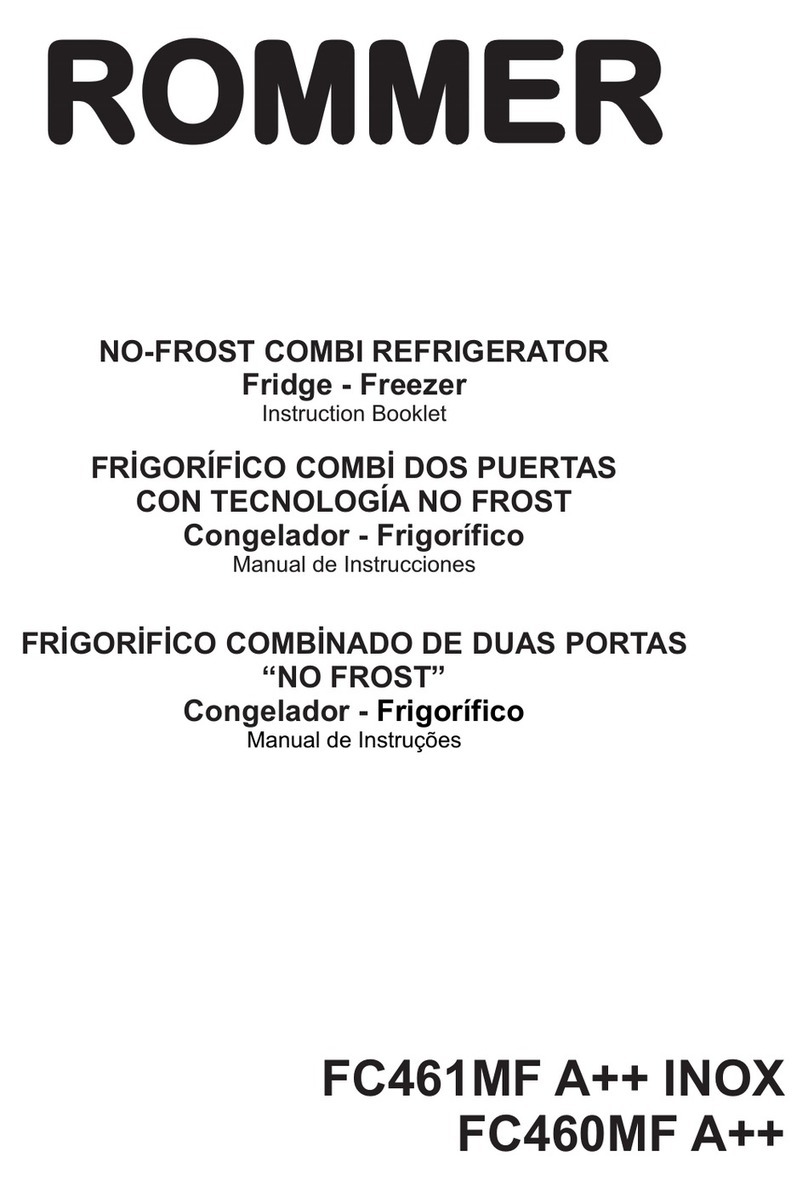
ROMMER
ROMMER FC461MF A++ INOX User manual

ROMMER
ROMMER FCM 316 INOX User manual
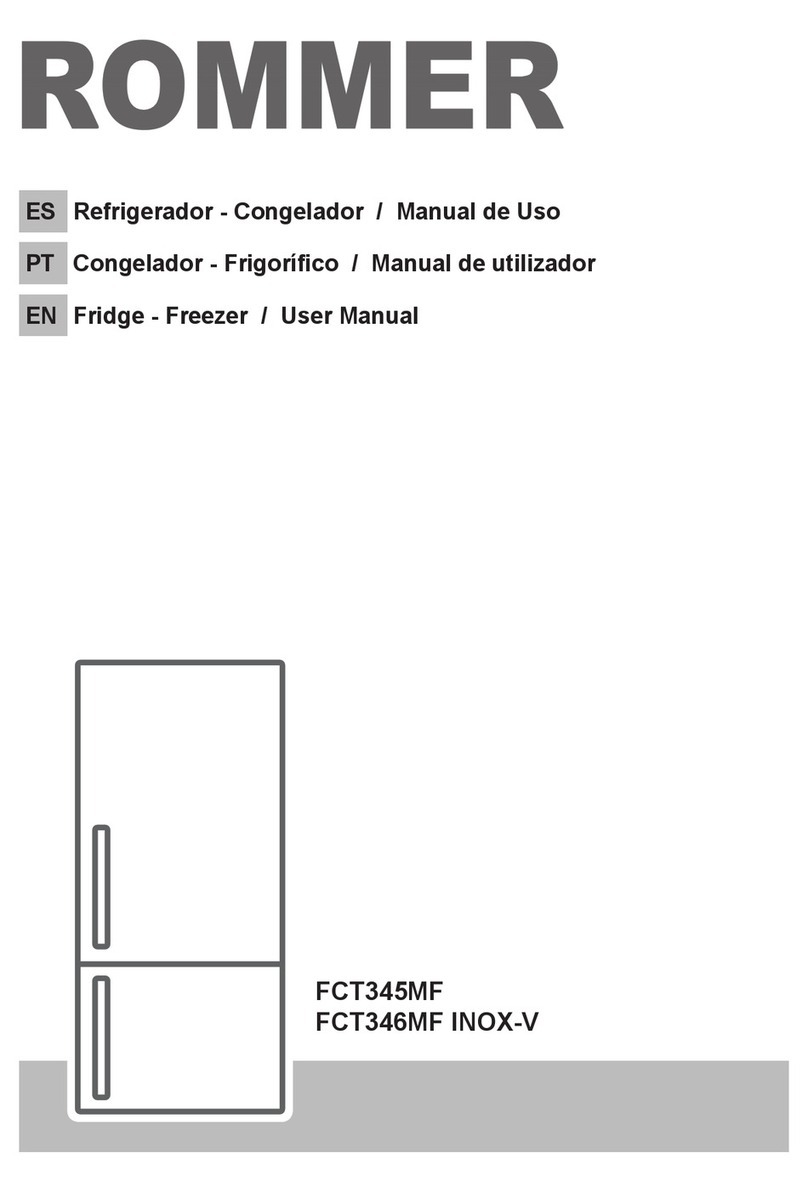
ROMMER
ROMMER FCT345MF User manual
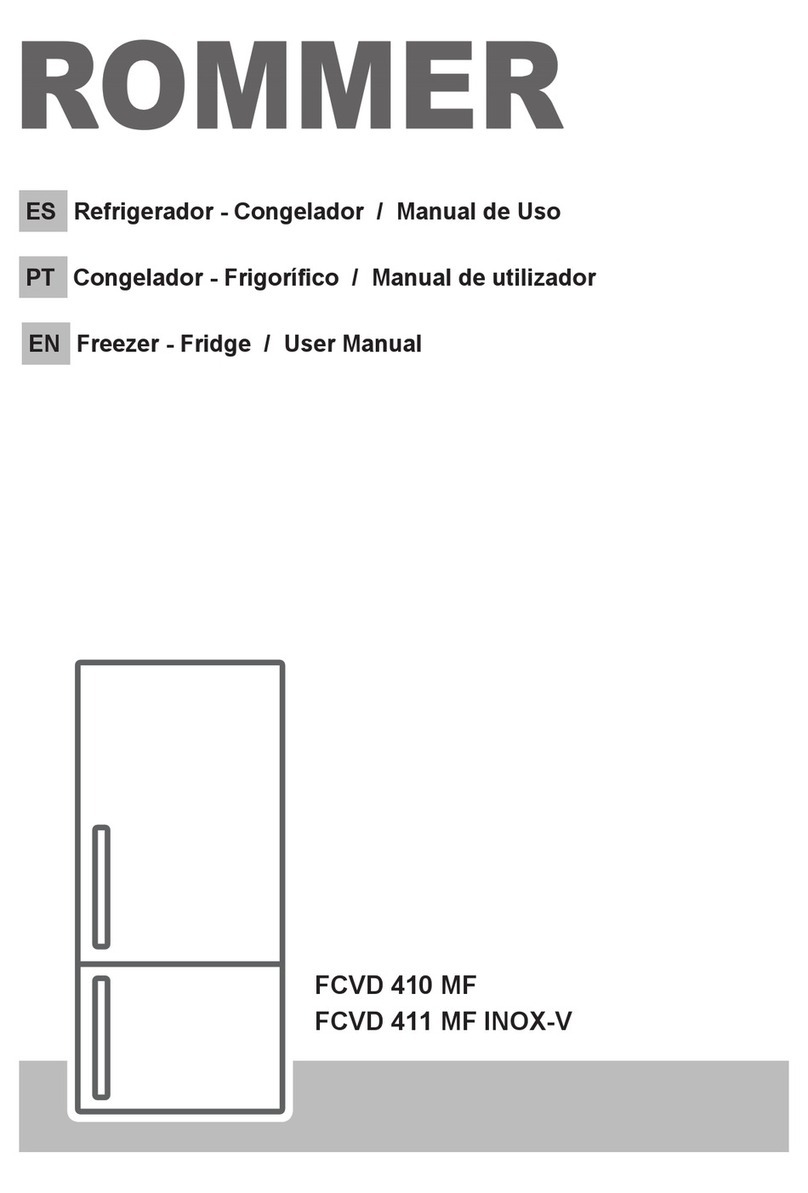
ROMMER
ROMMER FCVD 410 MF User manual
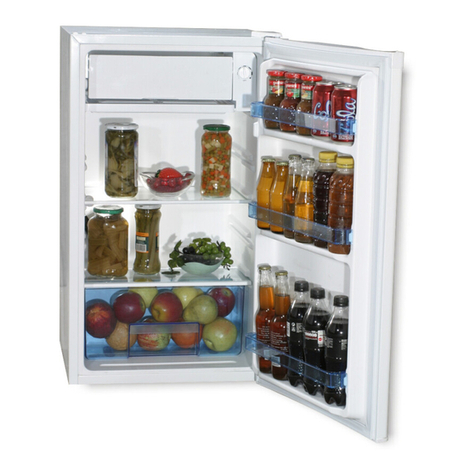
ROMMER
ROMMER F 101 A+ User manual
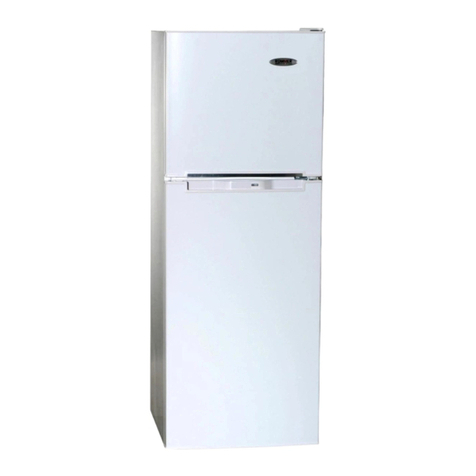
ROMMER
ROMMER F 241 A+ User manual
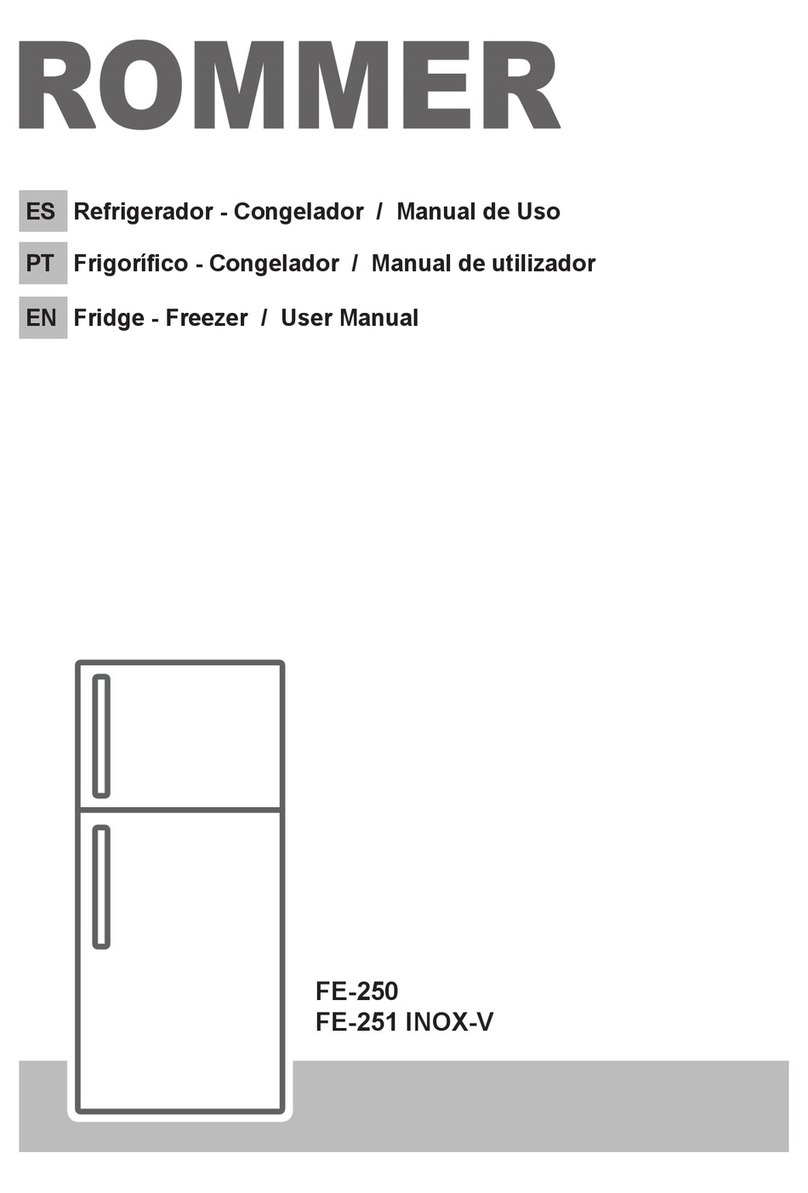
ROMMER
ROMMER FE-250 User manual
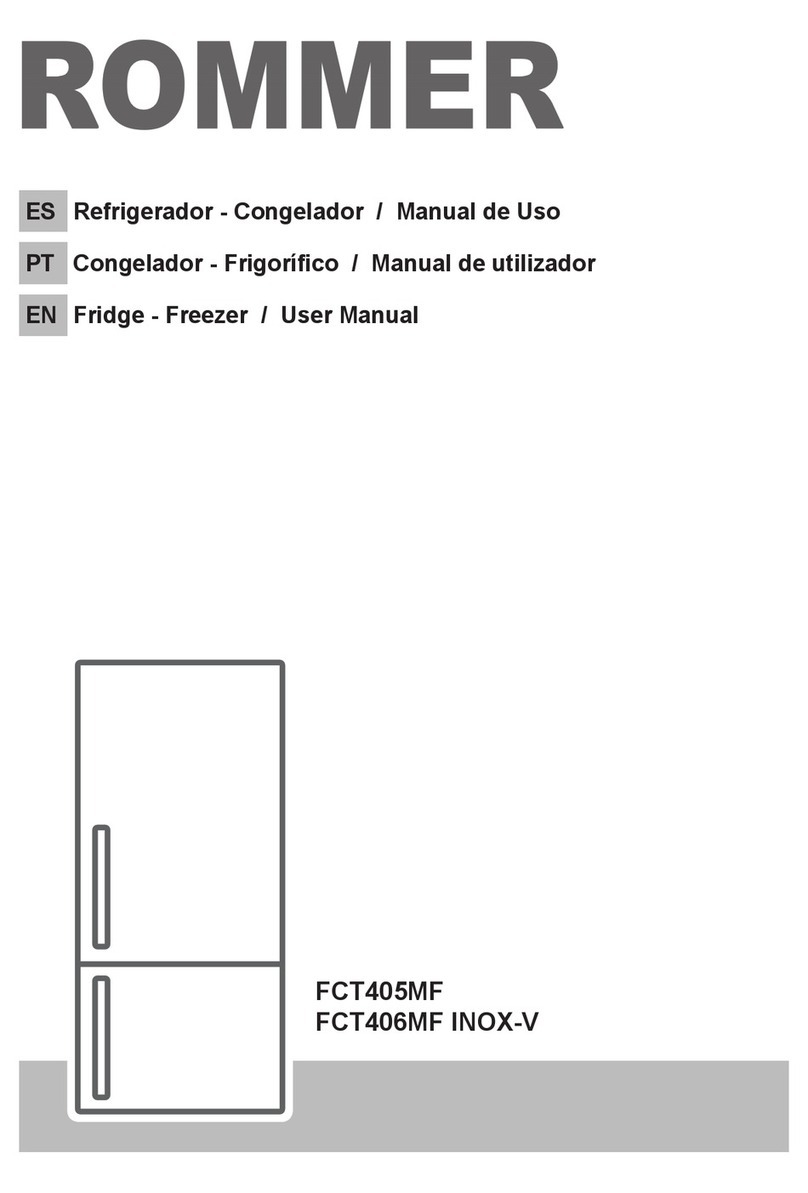
ROMMER
ROMMER FCT405MF User manual
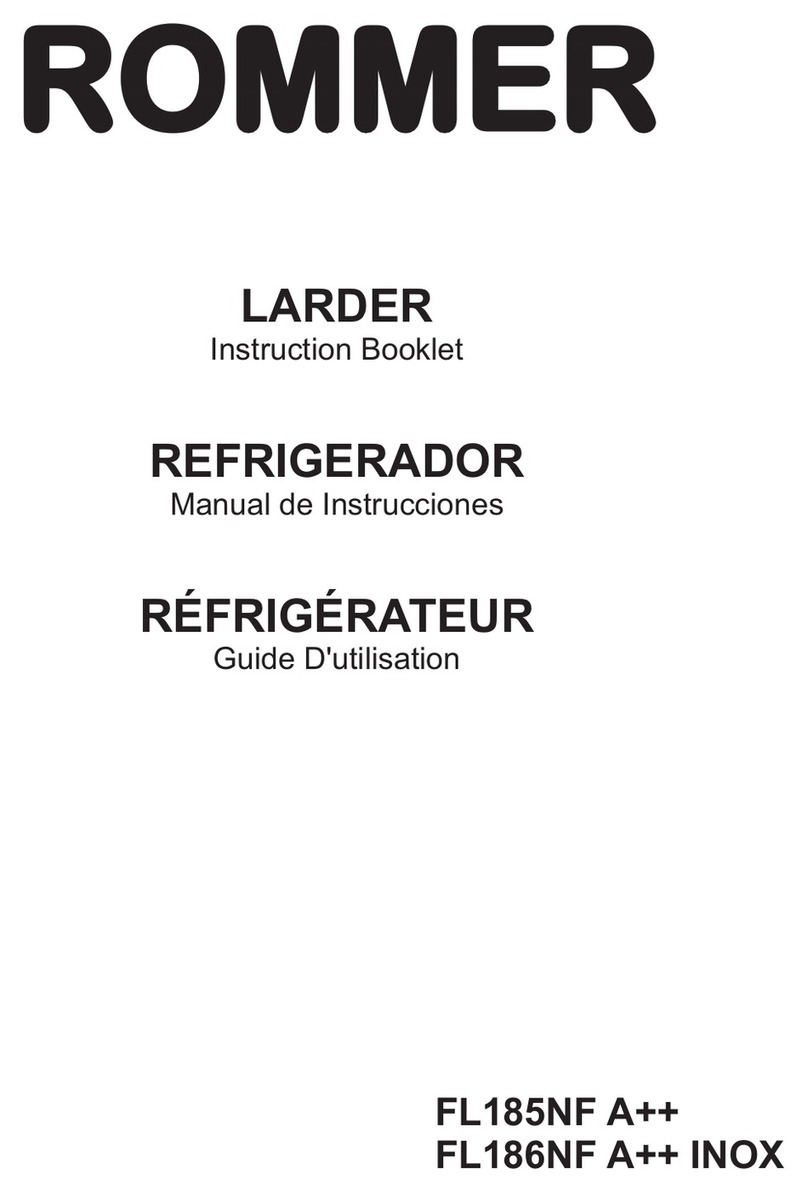
ROMMER
ROMMER FL185NF A++ User manual
Popular Refrigerator manuals by other brands
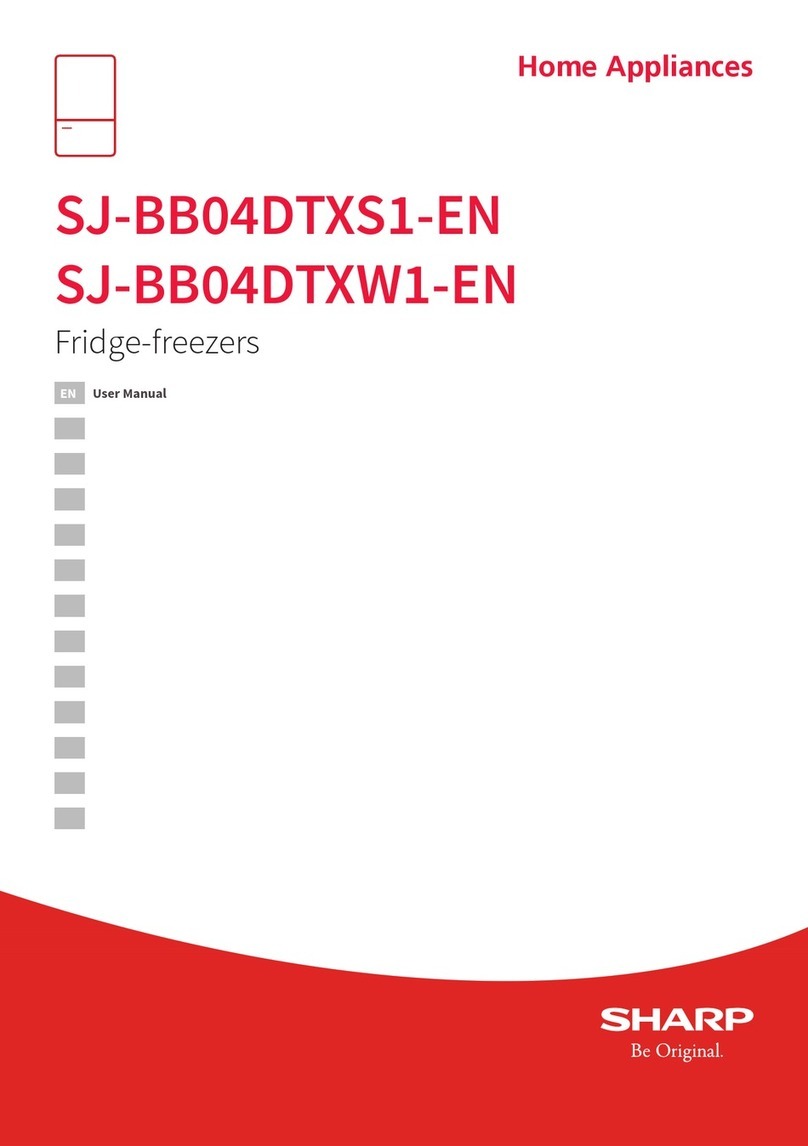
Sharp
Sharp SJ-BB04DTXS1-EN user manual
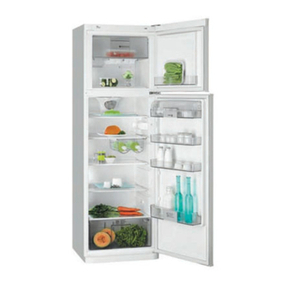
Fagor
Fagor FD-291NF Instructions for use

GE
GE GE Energy Star GDSL3KCYLS Dimensions and installation information
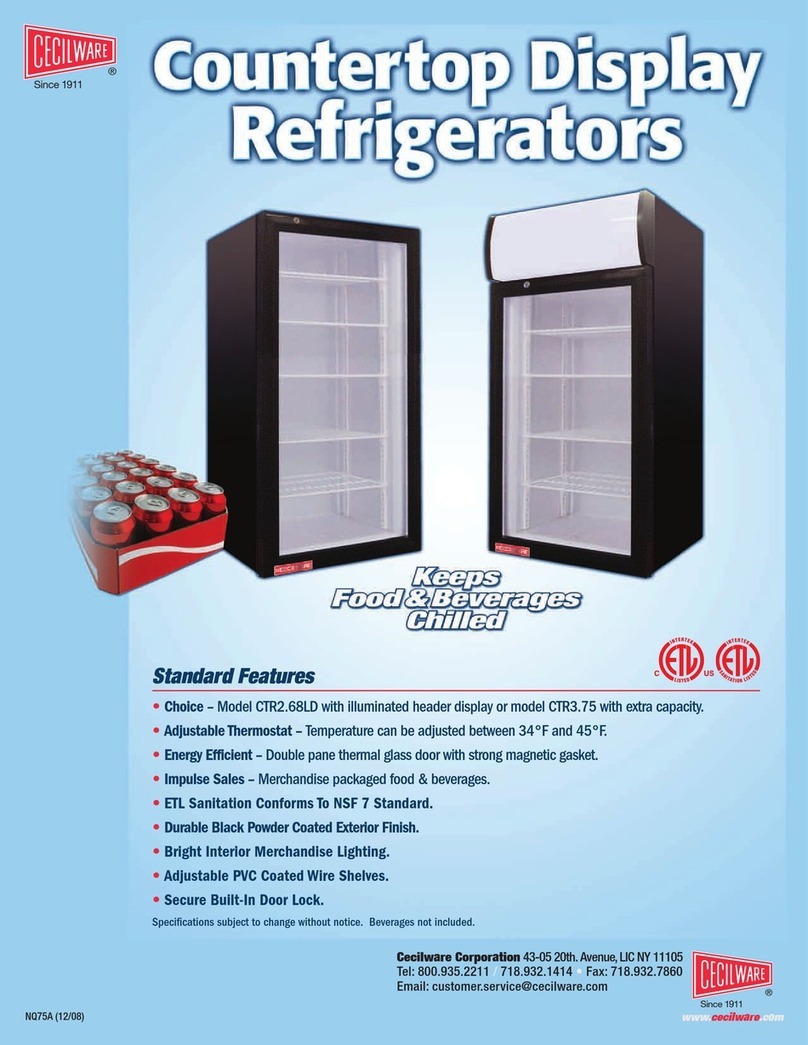
Cecilware
Cecilware 8725 Specification sheet
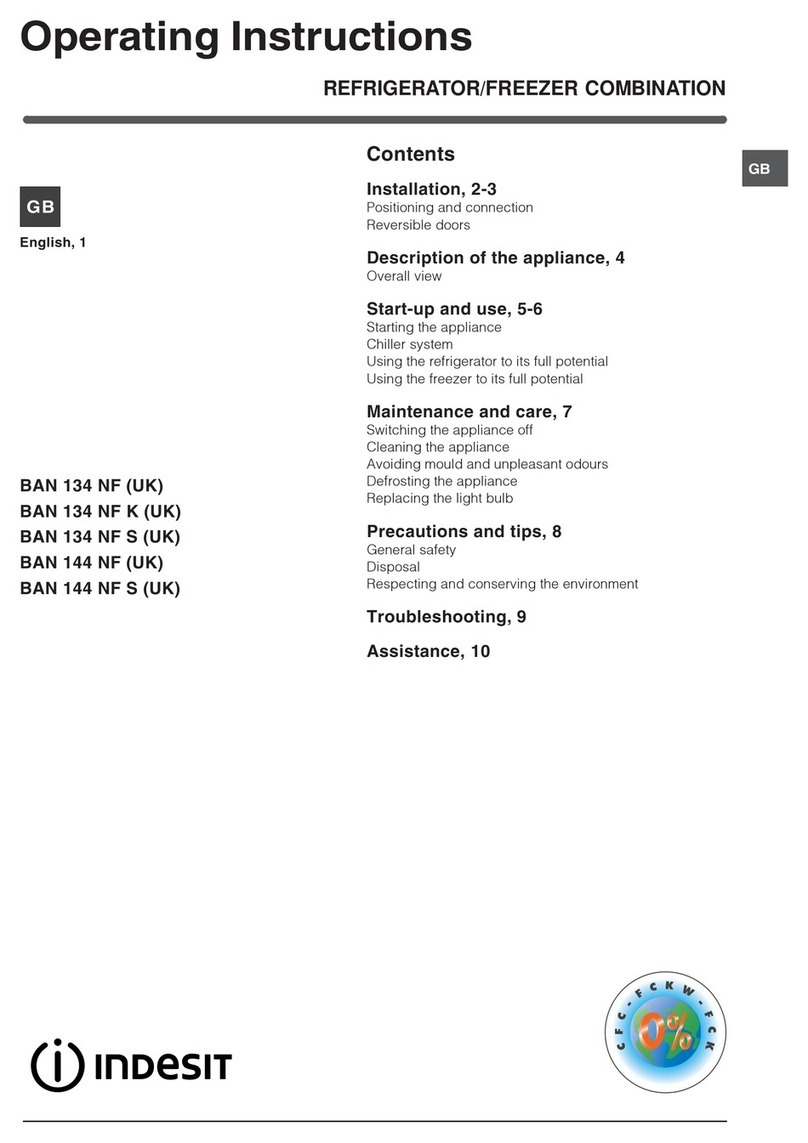
Indesit
Indesit BAN 134 NF K operating instructions
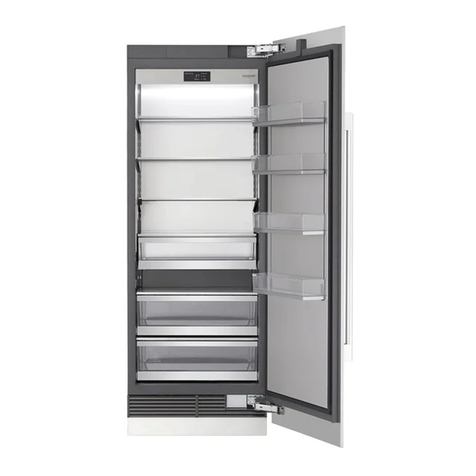
Signature Kitchen Suite
Signature Kitchen Suite SKSCR3001P owner's manual
